 "/>
"/>
 "/>
"/>

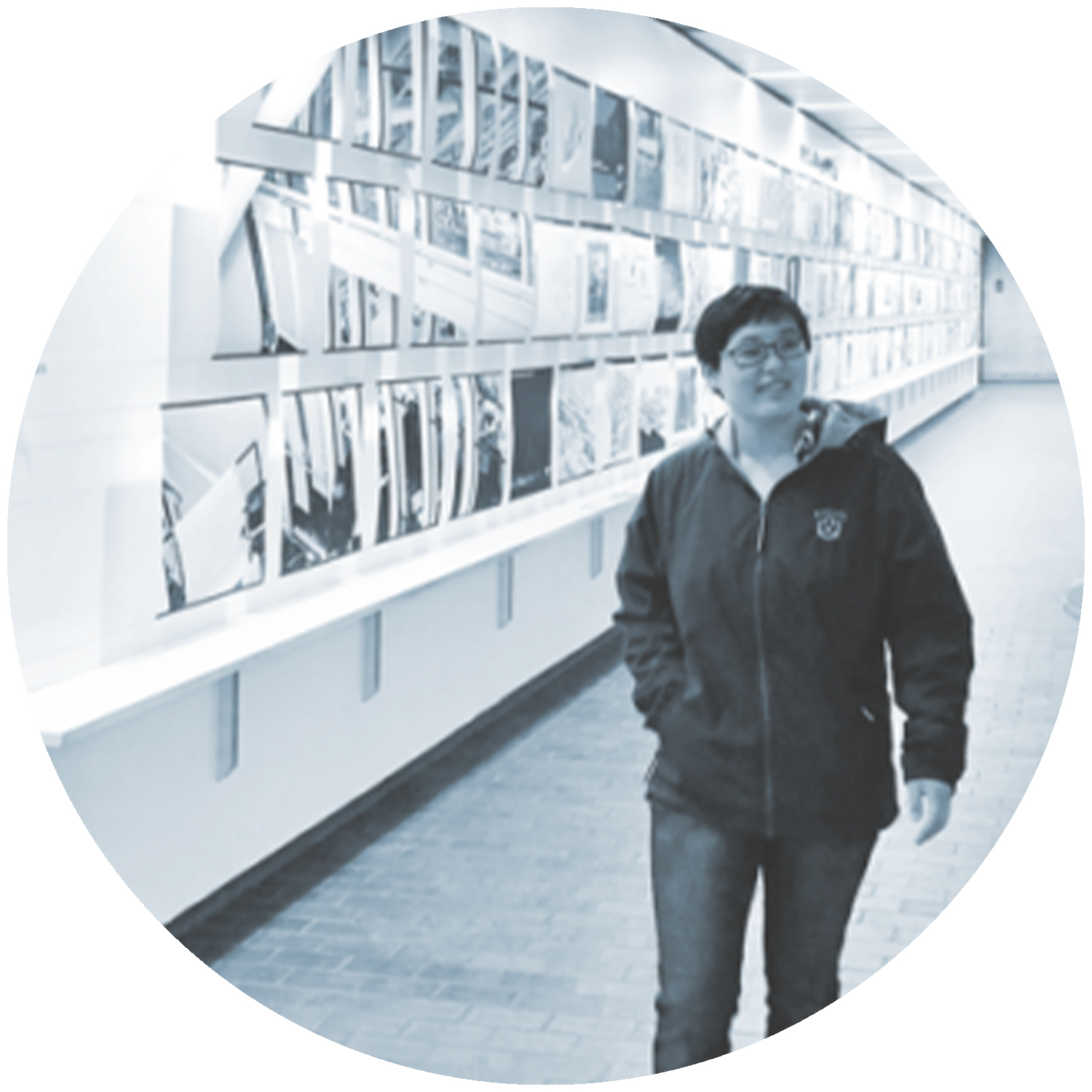
Christin Hu
upinthenimbus@gmail.com
HARVARD UNIVERSITY GSD, MLA
哈佛大学设计学院景观建筑硕士
MACAULAY HONORS COLLEGE AT THE CITY COLLEGE OF NEW YORK (CCNY)
Spitzer School of Architecture (SSA), B.Arch
纽约市立大学(CCNY)建筑学荣誉学士
通过这种便捷的方式使公众在家能够随时设想共享景观设计方案,让人们有更多机会与景观专业人士和当地社区领导进行更有效的沟通。除此之外就是为公众提供了一个特定的平台,使其可以通过游戏结果与本地的景观设计师取得联系。
—Christin Hu
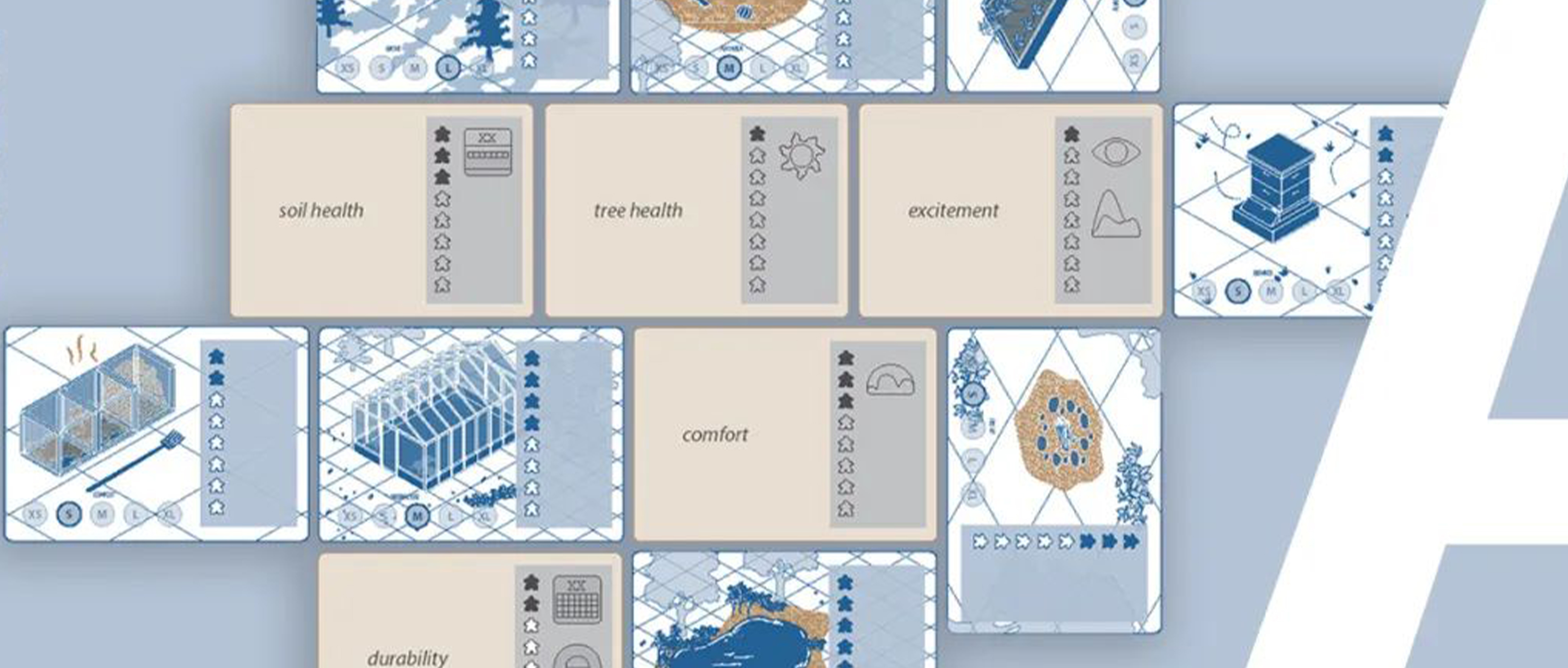
01 / 景观桌游的设计框架
Landscape Board Game Framework
█ 你本人是桌游的超级粉丝吗?为什么会选择“景观游戏” 作为毕业设计的主题?这是一个令人震惊的毕设主题吗?
Are you a super big fan of tabletop games? How did you pick the topic of Landscape Game for your thesis at GSD? Is this the most outrageous thesis topic ever?
C:我的确非常喜欢桌游, 因为许多桌游都需要协同合作,而我也很享受跟同伴一起获胜的快乐。选择这个主题作为毕业设计是出于众多因素的综合考虑,包含我对游戏本身的兴趣,也包含想要发展潜在的参与性实践的想法以及我在当地城市农场的志愿经历。这的确是一个独特的主题,但这并不是第一次有人想要通过游戏的方式来完成毕业设计。我认为这个项目的独特之处在于,它将设计关系贯穿于整个项目过程与方法中,类似于玩家在游戏当中所做的。因此,已有一些关于公共建筑项目和城市规划的游戏,但没有什么能比 “景观游戏”更能在景观建筑领域独树一帜的了!
另一方面,我从小学就对游戏感兴趣,所以对我来说这并不是一个非常震惊的毕业设计主题。事实上,它帮助我认清什么是自己喜欢做的事,以及作为一名设计师我想要做什么。通过这个过程,我发觉一切都有源可溯。
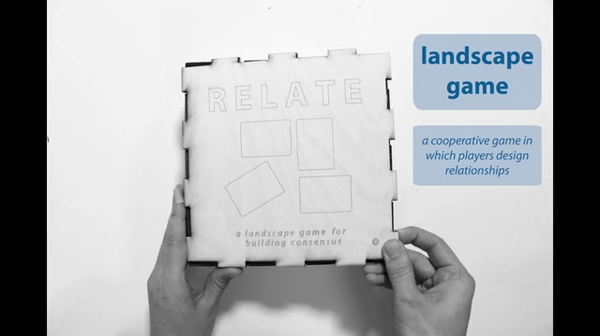
游戏介绍视频
Yes, I enjoy board games a lot! Many board games are cooperative, and I like winning together. The topic of my thesis project came from a mix of things including my interest in games, but also the potential of expanding participatory design practices, and my ongoing volunteer work at a local urban farm. The design of a “landscape game” is definitely a unique thesis. But it’s not the first time anyone has ever done a game for his/her thesis project. I think what’s special about this project is that it embeds designing relationships throughout its process and methodology, similar to what players do in the game itself. While there are many “games” that are typically supplemental to public architecture projects and urban planning, there was not anything quite like a “landscape game,” which makes it unique in the landscape architecture department.
On the other hand, I do not think it’s an outrageous thesis topic for me, as I have been interested in games ever since grade school. It actually helped me to figure out what I enjoy doing and what I would like to do as a designer. Throughout the process, I felt like it just made sense because it was really a combination of prior volunteer experience at the urban farm, plus meeting other people who really like games, plus actually playing those games. I also got a lot of encouragement from my advisor during my semester!
█ 您是在何时产生了这种用游戏来促进公众参与的想法?您的课题研究是否有受到与桌游相关的经历、课程或书籍的影响?
At what point did you come up with the idea of using games as a way to get the public involved? Are there any experiences/courses/books related to tabletop games that influenced your research?
C:大概是在哈佛大学设计学院开学不久之后,那时我也同时开始在Haley House Thornton Street城市农场和社区花园进行志愿服务。在那里,我结识了在城市农场工作的人们,发现他们也玩桌游,那也是我第一次接触并开始玩“龙与地下城”这个游戏。从那时起,我开始筹划名为Relate的游戏,其中借鉴了许多我接触过的游戏。在各种游戏类型中,我最喜欢的是合作游戏,因为合作游戏可以让我和家人朋友一起玩并实现共同的目标。我认为正是这些游戏里某些机制上的力量,让我决定将他们运用到我的毕业设计中。
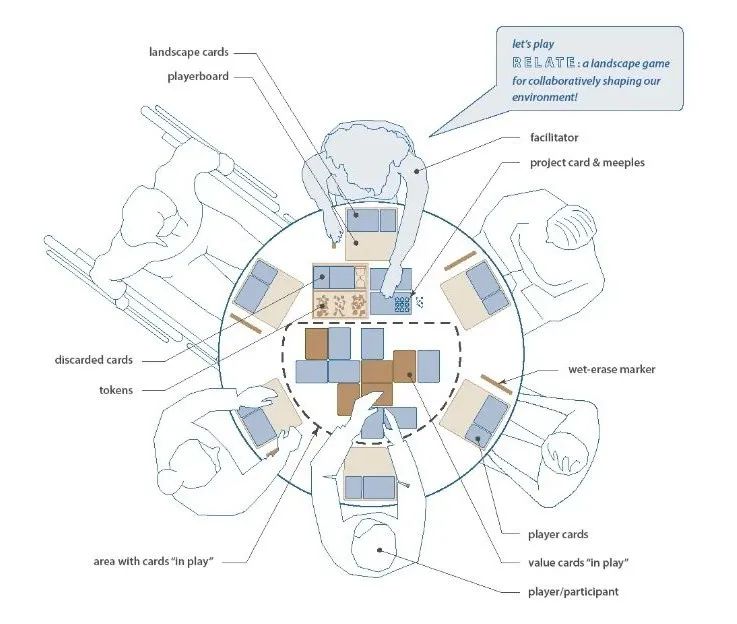
游戏场景示意图
毕设的那个学期,我选了一门游戏设计课程,在麻省理工学院学习游戏设计与开发。(https://education.mit.edu/course/cms-590-11-127-cms-863-11-252-design-and-development-of-games-for-learning/)这门课对我的毕业设计产生了很大的影响。该课程专门针对游戏设计,因此我也有机会阅读了很多关于游戏教育的文献。那也是我开始在进行教育类的游戏设计中关注价值观的一个起点。
另一个相关的经历是我和我的朋友们(Nick,Savannah,Colin,Aysha)一起在设计学院组织了一个游戏俱乐部叫做Game!GSD。我们会在晚上的设计学院里组织游戏之夜的活动,内容就是玩游戏和讨论游戏相关的话题。在这个活动里,我们会遇到其他系对游戏设计感兴趣的人,他们很多人正在为各自以游戏为主题的毕业设计或论文做测试,我们也因此有机会测试其他人的游戏。于我们来说,这是一个完全沉迷在游戏机制中以及从现有的游戏中学习的机会。
关于书籍的话,有一本Josh Lerner写的《使民主变得有趣》的书非常不错。这本书介绍了游戏可以对我们做决策的过程产生影响。可以说,一个人在玩游戏时要做决定,跟在做设计的过程中要做决定,本质上是一样的。
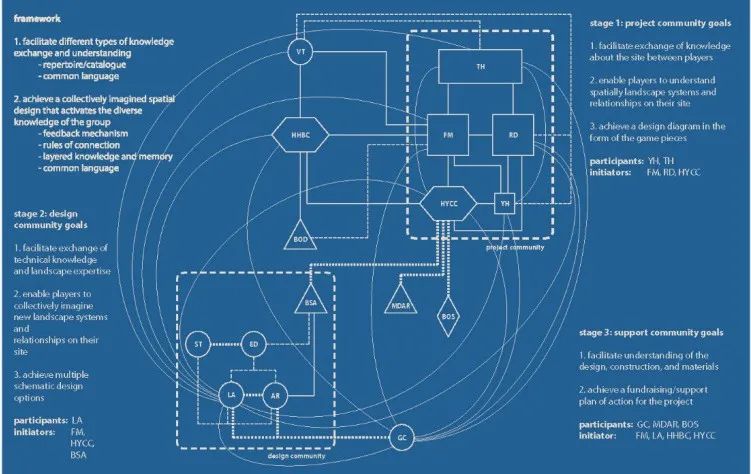
游戏参与者设计框架
It was probably a little bit after I started at the GSD and started volunteering for the Haley House Thornton Street Urban Farm & Community Gardens. At that point I was able to meet people at the urban farm and people there also played games. It was actually my first time playing Dungeons & Dragons at that time. Starting from there, I started to think about the game, called Relate. It draws from a number of other games that I’ve encountered. I like cooperative games the most, which can be played with families and friends towards a shared goal. I think it was really this strength of certain game mechanics that made me decide to include them in the project.
During my thesis semester, I took one game design class, Design, and Development of Games for Learning at MIT (https://education.mit.edu/course/cms-590-11-127-cms-863-11-252-design-and-development-of-games-for-learning/) that really made an impact on my thesis project. The class was game design specific, so I had a chance to read a lot of literature related to educational games. That's where I started to pick up things like certain values or aspects that people think about when they're designing educational games.
Another related experience was actually running a game club with my friends, Nick, Savannah, Colin, and Aysha, called Game!GSD. We essentially plan game nights at the GSD and just play and talk about games. We were able to meet other people in different departments who worked on game designs for their theses, and playtest other people's thesis projects. It was a chance for us to totally nerd out over game mechanics, as well as learn from existing games.
For books, there is one called Making Democracy Fun by Josh Lerner. It’s a really good book about how games can be impactful during decision-making processes. You’re essentially making decisions when you play games, which is also true of the design process.
█ 你讲到了你的许多志愿经历,可以和我们谈一下在整个毕业设计过程中这些经历是如何帮助你的?
As you mentioned a lot about your volunteering experience, could you talk a little bit more about how it helped you during the process?
C:在我整个毕业设计的项目周期中,在Thornton Street农场的经历都对我至关重要,不仅仅是因为我的游戏就是为在那里的人而设计,更重要的是,他们对教育类游戏有着批判性的思考,激励着我完成这个项目。而且我发现不论是在农场玩游戏,探讨设计还是做志愿服务,我都更愿意与人交流。
最初的游戏由很多元素组成,例如景观卡,并且受到了Thornton Street城市农场中诸多方面的影响。可以说,我的经历与项目过程之间的关系类似于画静物,都需要有一个具体的生活场景。如果没有这个场景,这个项目就不会存在。
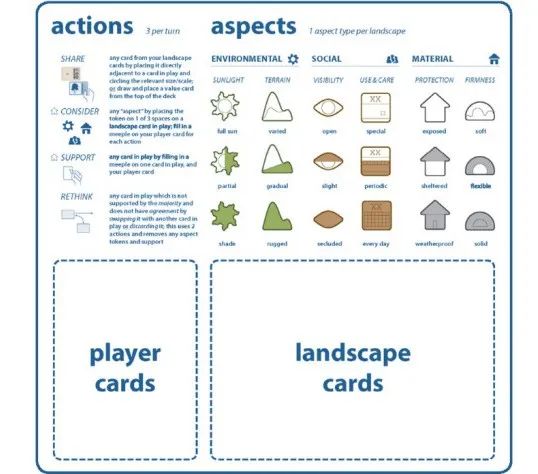
游戏板示意图
对我来说,在城市农场工作并成为社区的一员也是非常关键的。这些经历使我能够在城市农场开展毕设项目,并逐渐将这些元素融入游戏当中。我设法确保这些组成部分的通用性,以便它们可以应用于不同类型的项目,但同时它们也必须足够具体,以建立与游戏参与者之间的联系。在农作物生长的季节,我基本上每个月都会至少去一次农场,因此与单纯从书本上学习相比,这段与景观接触的经历也更加独特。除此之外,农场旁还有一个Hawthorne青年社区中心,在那里我也有机会和小至八岁的邻居一起进行游戏测试。
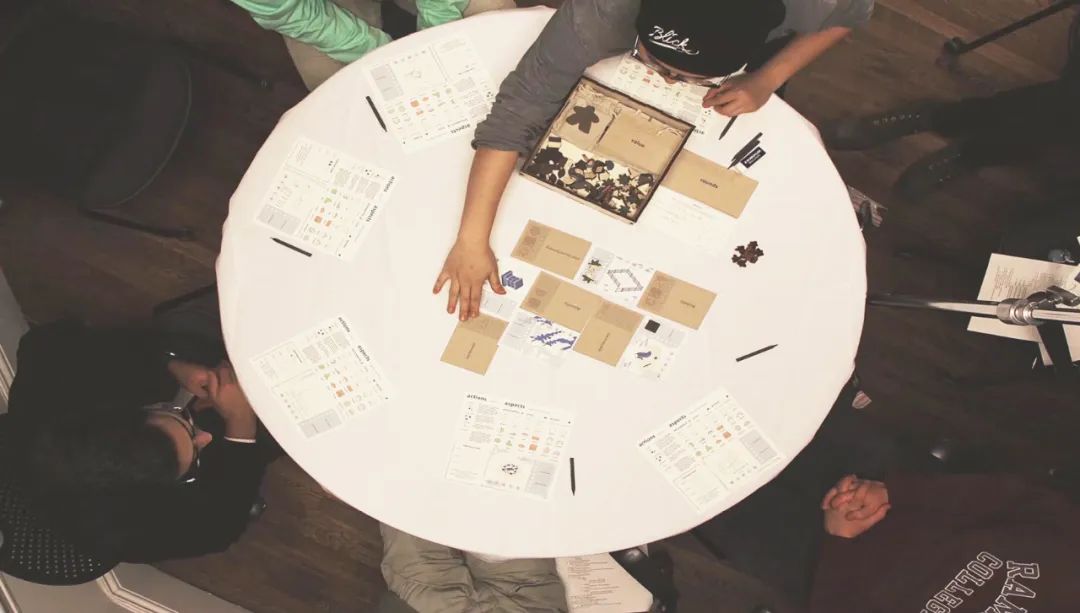
与社区朋友一起进行游戏测试
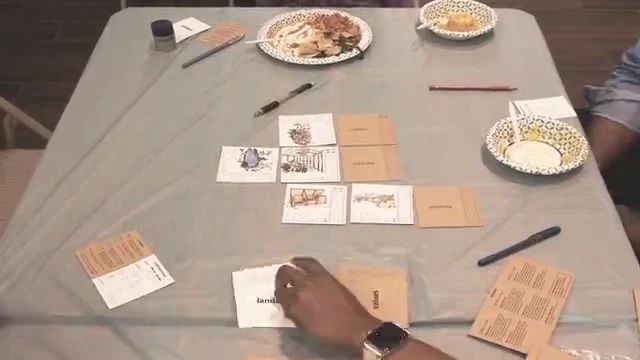
游戏测试
The volunteering experience at Thornton Street Farm was really important to me during my thesis, not only because they were essentially the people I was designing the game for, but also because they were the people who really helped motivate me to do the project. They think critically about educational games, and I found out that when I play games and talk about design as well as volunteer at the farm, I'm more open to talking to anyone.
The initial game has a lot of elements like landscape cards and was influenced by aspects that you would find on an urban farm. The connection between my experience and the project process is sort of similar to doing a still life drawing that needs to have a context – the “life.” Without that, the project would not exist.
It was also important for me to work at the urban farm and be a part of the community. It helped to start the project at the urban farm and gradually incorporate elements into the game beyond that. I tried to keep the components general enough so they can be applied to different types of projects, but they also had to be specific enough so that people can relate to them. I went to the farm at least once a month during the growing season, so it allowed me to be in touch with the landscape differently than purely learning from books. There was actually another organization next to the farm, the Hawthorne Youth and Community Center, where I was also able to playtest the game with the neighbors as young as eight years old.
█ 设计游戏和做设计项目最大的区别在哪?过程中有遇到一些挑战或者困难吗?
What is the big difference between designing a game and doing a design project? Any challenges or difficulties?
C:我觉得与设计桌游相比,学术项目的不同之处在于与人,尤其是与未来用户之间的真正联系。但是许多毕业设计项目仍是推测性的,并没有与假设客户或在社区进行实际测试,因此这些项目大多停留在提案阶段。而游戏的挑战和有趣的部分恰恰在于需要与真实的社区成员进行游戏测试,这个过程中充满了不可预测的反馈,我们要依此进行不断的完善。在游戏设计的过程中,游戏玩家需要亲自体验游戏,这与典型的自上而下的建筑过程相比,更注重实践操作,例如在地里感受土壤和种植南瓜,二者是完全不同的角度。因此,游戏设计有助于让我进行更现实的思考,就像人们在设计共享社区花园时所需要的思维一样。
图片
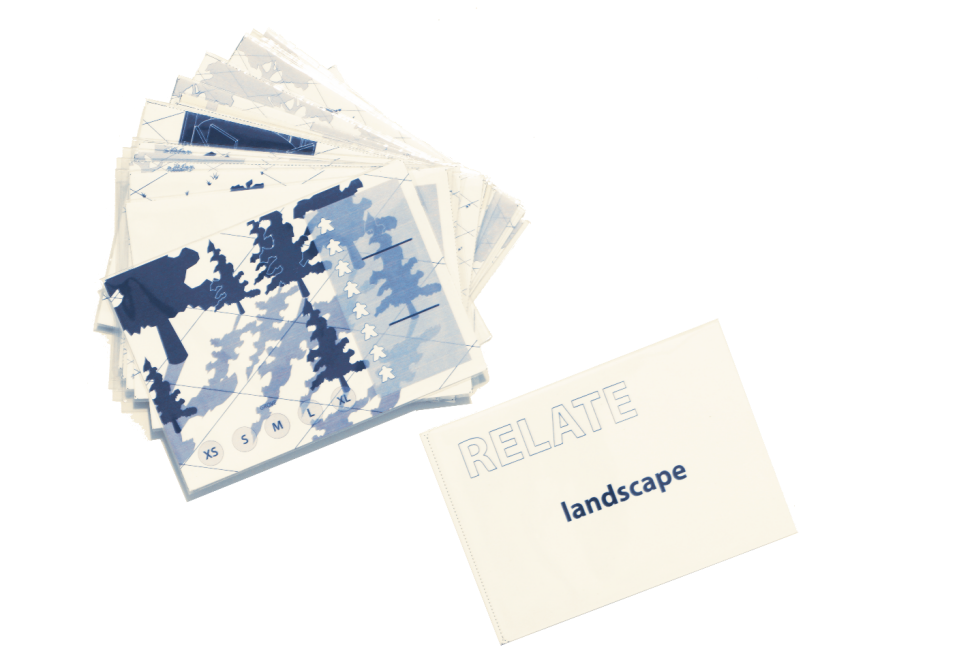
游戏卡片
这个项目的最大挑战之一就是我必须测试游戏并且确保它可行。但如果将学校的毕业设计项目视为假设项目的话,是不需要测试或者实际建造的。这对我来说无疑是一个挑战,却也是这个项目的一个乐趣所在,因为我必须要找人一起玩游戏。而且仅仅是在确保自己拥有正确的资源就已经很困难的前提下,还需要在进行游戏测试之前做很多准备工作:除了设置录音装备,还需要准备一系列有针对性的问题,以得到本次游戏版本测试中我想要的反馈。
之所以我觉得这很困难是因为,我的毕业设计只有一个学期的时间来做。在总共10次游戏测试中,我在每次测试之后都会进行一次版本的更新和完善,某种程度上也就相当于我在做10个小项目。这绝对是一个挑战,但同时也充满乐趣。
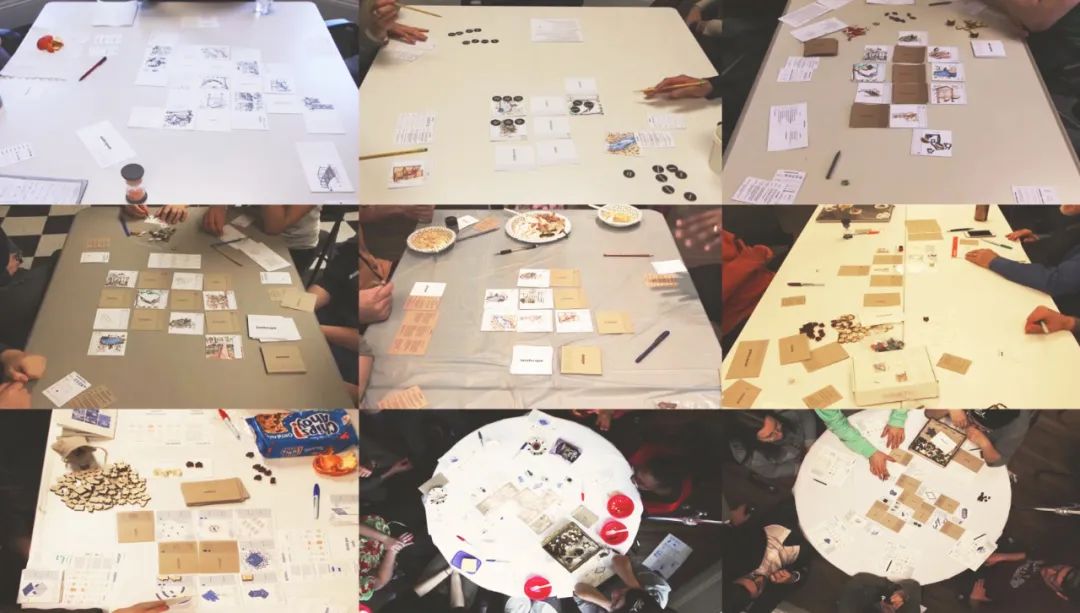
游戏测试记录
I think what’s different about an academic project as opposed to a tabletop game design is the real connection to people, particularly the future users. Many thesis design projects remain speculative and untested with hypothetical clients or communities that are rarely partnered with – they stop at the proposal phase. The challenge, and the fun part, of the game, was the playtesting with real community members, integrating unpredictable feedback, and constantly iterating. In game design, you need players to actually play the game. It’s a totally different perspective compared to the typical top-down architecture process, and it is just about being on the ground, like touching the soil and planting squash. So, it helps me think realistically, like what people actually need when they design a shared community garden.
One of the biggest challenges of this project is the fact I had to test the game and it had to work. Whereas when you design a school project as a hypothetical landscape project, you don't need to necessarily test it out and build that landscape. It was definitely a challenge, but it was also part of the fun because I got to play the game with people. I would say it was really difficult to just make sure that I had the right resources. There was actually a lot of set up behind the meetings and the playtests that I did. For example, I had to prepare a list of questions and be very intentional about what type of feedback I wanted for that particular iteration in addition to setting up recording equipment.
I think it was particularly difficult because it was over the course of just one semester. I did one iteration in between each of the 10 playtesting sessions. It's almost like doing 10 mini-projects in a certain way. It was definitely challenging in that aspect, but a fun challenge.
█ 你还保存着之前所有版本的游戏卡片吗?第一个版本是怎样的?
Do you still have cards for all those versions? What did the first version look like?
C:所有的版本都保存在我纽约的家里。第一版卡片非常大,是粗制的黑白卡。我还留存了很多与我毕业设计相关的视频。在每一代版本中,我都基于卡片本身的形状(从六边形到正方形再到矩形)修改了游戏的结构。我甚至觉得在整个过程中,卡片的设计还可以改变更多。
Yes, I do keep all the versions at my home back in New York. The first version had huge, sketchy, black and white cards. I have a bunch of videos pertaining to my thesis project. Between each generation, I changed the structure of the game itself a lot on top of the cards themselves, from hexagons to squares to rectangles. I would say that the graphics probably could have changed more throughout the process.
█ 在你的游戏设计当中,游戏结构和视觉设计哪个更重要?
Which one do you think is most important in your game design, structure or graphics?
C:我认为这两者都很重要。事实上在整个过程中,我更加侧重考虑游戏机制的作用方式,而不是游戏的视觉设计。但是通过回顾评图期间我从教授那里得到的反馈,我意识到本可以在游戏的视觉设计上做出更多的努力。
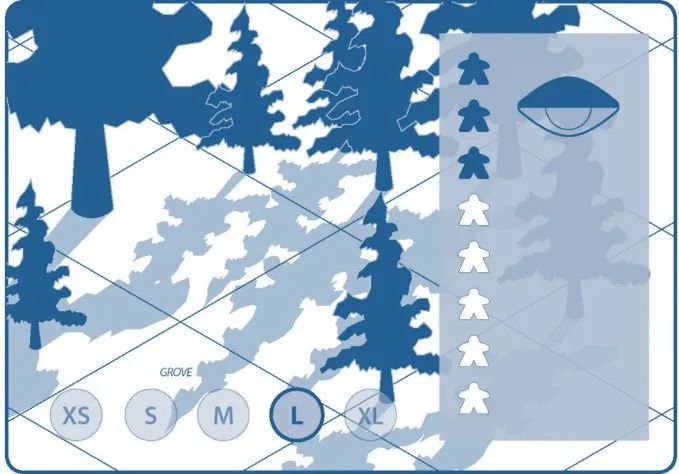
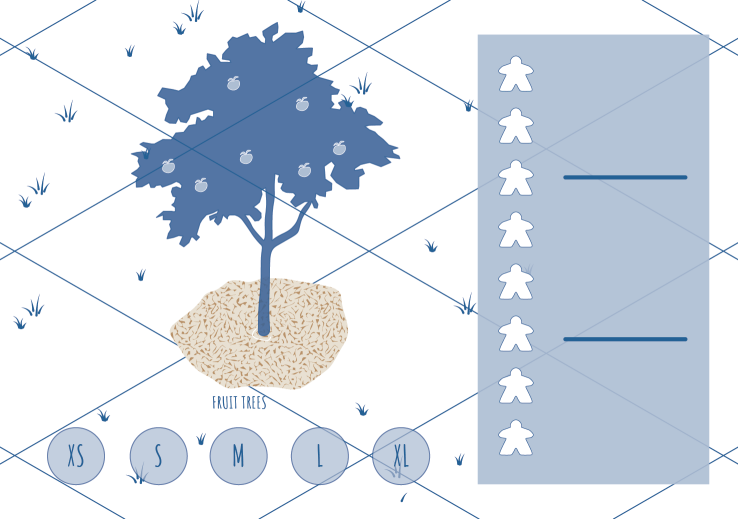
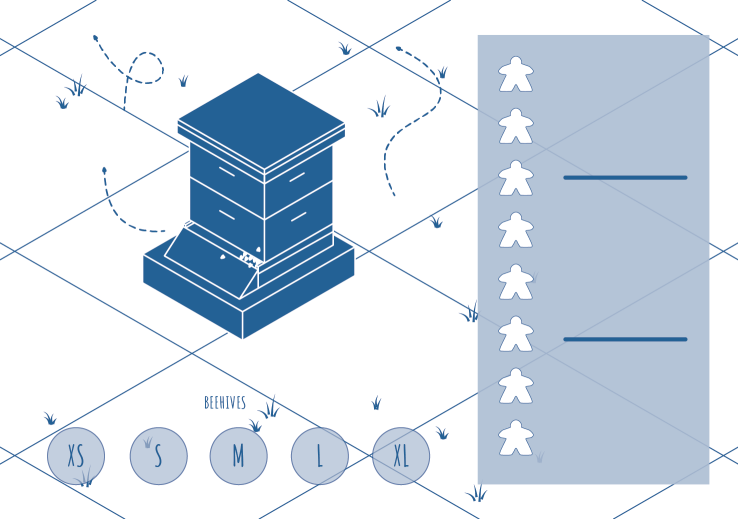
游戏景观卡
我现在正在通过Patreon (https://www.patreon.com/nimbusbud)开发的版本试图更具批判性的去考量游戏的视觉设计,因为我认为易于理解视觉设计对游戏而言至关重要。另外,我很喜欢思考视觉设计的原理:游戏卡片不可太粗糙,但也不必太机械。所以我试图在两者中寻找一个平衡。
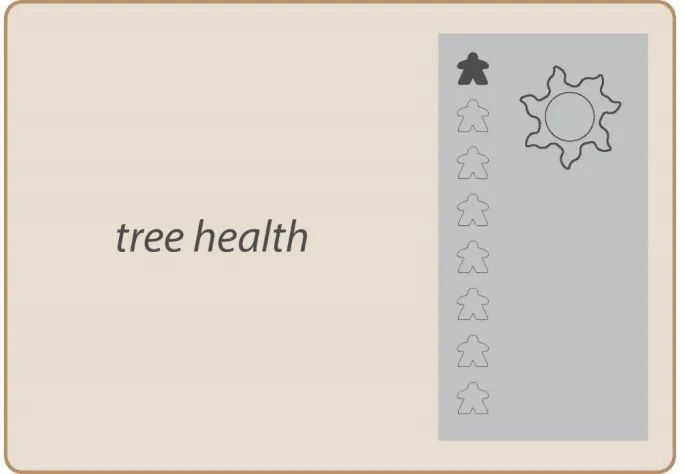
游戏景观价值卡
这让我想起我在纽约市立大学建筑学院的毕业设计项目,其中涉及到很多自我探索,关于如何绘画以及我想如何用我的方式去画。当时的我是更有意识地将我想要呈现在纸上的东西视觉化。但我认为对于这个景观游戏项目,我正在尝试找到文字、图标、和图画之间的平衡,并通过游戏卡片准确地传达景观设计的体验。正如艺术家向观众传递他们的艺术构思或是建筑师将设计准则融入到项目中的各种部分那样。在这个景观游戏的设计过程里,所有的小细节都至关重要。
I would say they are both important. In fact, during the process, I was prioritizing more on how the game would work rather than the graphics of the game. But looking back at the critique I received from my professors and other instructors during reviews, I realized that I could have pushed more on the graphic aspect of the game.
The version I am developing now through my Patreon (https://www.patreon.com/nimbusbud) is really trying to consider graphics more critically, as I think it is crucial to have understandable graphics. Also, I enjoy thinking about how certain graphics work: the cards don’t have to be so sketchy, but it doesn't have to be so mechanical either. I am trying to find a balance in between.
This actually reminds me of my thesis project in architecture school at CUNY City College, which involved a lot of discovering of myself about how to draw and how I wanted to draw personally. I was more intentional about what I was putting on the paper as a visual cue at that time. I think for this landscape game project, I am trying to find the right balance of text, icons, and drawings to accurately convey the experience of the designed landscape using game cards. It’s similar to artists trying to convey their artistic ideas to their audiences or architects incorporating a design standard for accessibility with the other elements of a project. All small details matter as well in my landscape game design.
█ 你是否有考虑过将这款桌式游戏产品化?
Have you ever thought about introducing this tabletop game to the market?
C:这正是我所希望的,并且我正在为此而努力。我下一步可能会通过Patreon开发一个免费版本,之后会优化并在Kickstarter网站上众筹,最终会是需要付费购买的高级版本。初始版本我希望可以使用简单的黑白打印机和适宜打印机尺寸的纸张在家里制作完成,这有助于扩大受众范围并获得大量反馈。而且通过这个过程,我需要了解到我的受众群体是谁。
考虑到目前我有一份全职工作,所以我还没有预设这款游戏会进入商业的运作模式。但是对于未来的市场来说,我认为景观建筑师、建筑师、市政府以及学校可能会对这款具有教育和设计方面意义的游戏感兴趣,并可能会为该项目投资。如果是这样,我可能会需要一个全职团队来负责这个项目。
目前,我想要在景观建筑领域获得更多经验。实际上,在现阶段的工作中,我参与的公共会议就有助于我理解这款景观游戏是如何更贴近现实地去运作。另外,我还需要一些时间去认识和剖析自己,并找到合适的团队来运作该项目。总之,我的目标是,让这款游戏成为一项可以养得起整个团队的全职工作。
Yes, that’s the hope. And I am currently working on it. The next step would probably be a free version through Patreon, then a Kickstarter project, which eventually will be a fancier version that people can purchase. I hope the first few versions will be easily printed at home using simple black and white printers and letter size paper. This helps to reach broader audiences and get a lot of feedback. Through this process, I have to get to know who my audiences are.
And for now, because I am getting paid at a day job, I haven’t expected this game to be a business model yet. But for future marketing, I am imagining landscape architects, architects, city governments, or schools may be interested in this game for both educational and design purposes and would potentially invest in this game. I would probably also need a full-time team working on it.
For now, I would like to get a little bit more experience in the field of landscape architecture. In fact, in my current job, the public meetings that I attend help me to understand how my game will work more realistically. I need some time to get to know and learn more about myself and also find the right team to work on the project. But eventually, I will work fulltime on it and be able to pay for the team. That’s my goal.
█ 有没有考虑过将这款游戏做成移动应用程序APP,以便更多人可以更方便的参与到游戏当中?
Will you put this landscape game as a mobile app on the market so that more people can play without buying the cards or print at home?
C:目前我应该不会这么做。虽然我在毕设学期做这个项目用了大量的纸张,整个过程也挺浪费的,我也在考虑如何以一种更友好的方式来保护我们的环境。但我真的希望人们在玩游戏的时候可以面对面交流。尽管有些游戏可以让处于同一空间的人们共同通过手机来进行游戏,但是桌游的物理特性会让游戏玩起来更有代入感。而且与家人朋友在现实中一起游戏和互动要比大家虽然坐在一起,但大部分时间还是各自面对手机的体验好得多。
据我所知,许多决定都还是在面对面的会议中完成的,就像你不会在与公共机构的会议中做看着你的手机去做有关公园等事的重大决定。因此,面对面的互动对我而言意义重大,这也是我想要保持桌游本身物理属性的最重要的原因。但这并不表示这款游戏不会做电子版本。事实上我认为电子版本与实体版本应该具有不同的用途,实体版本有着更好的决策效果和设计表现,那数字版本就可能会更多用于涉及研究和解决需要复杂计算或视觉效果的项目技术挑战。
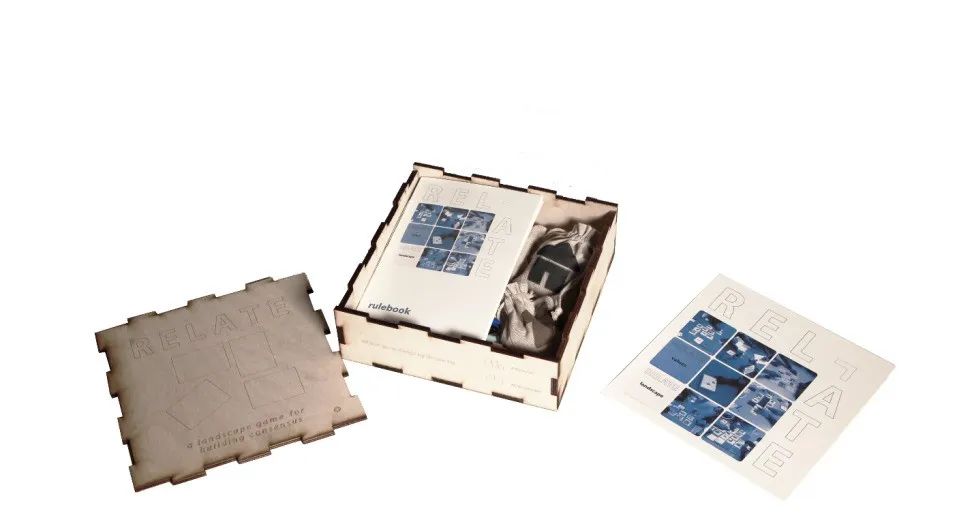
游戏实物
I don’t think I will do so...yet. During my thesis semester, I used a lot of paper for this project. The whole process was actually pretty wasteful. So, I was thinking of how to be more sensitive in a way to protect our environment. But I’d like people to have face to face interactions when they play the game. Though there are games people can play together on their phone while also being in the same room, the physicality of the game will make it more accessible. It’s more important to be present with family and friends and interact with one other physically, instead of playing games together but looking at phones most of the time.
Many decisions are still made during face-to-face meetings, and you wouldn’t look at your phones when you are in a meeting with a public agency trying to make a very important decision about parks or something. Face-to-face interaction is really important to me, which is the most important reason why I would like to keep the game in a physical form. But I am not saying it cannot be digital. I think the digital version should have a different purpose compared to the physical version. While the physical one involves more decision-making power and design, the digital could be more about research and addressing the technical challenges of a project requiring complex calculations or visuals.
█ 你曾经有做过类似的游戏设计项目?
Have you ever had similar projects like designing games?
C:没有。这是我第一次设计一款实体的桌游。但我记得我曾在本科的建筑学院上过一节叫做“食品与建筑”的课程。这门课非常有意思,因为每个小组需要每周向全班展示一种不同的食物或向全班传达一种想法。从本质上看,这更像一个类似研讨会形式的小实验。我觉得这个课程的构架很像在进行游戏设计,却不是一个完整的游戏设计项目流程。
I don't think so. It was the first time that I designed an actual game. But I remember when I was in architecture school, I took one course called Food and Architecture. It was an interesting class because each group needed to present a different food or communicate a certain idea to the class every week. Essentially, it was more like an exercise trying to put a workshop together. That, I think, was related to designing a game, but it was not a full game project.
02 / 景观桌游鼓励观众参与设计
Landscape Board Game
help the public involved in the design process
█ 公众如何通过此款游戏与景观设计师合作,参与设计?
How can the public collaborate with landscape designers by using this game?
C:这个游戏希望公众在家就可以完成卡片打印并进行游戏。通过这种便捷的方式使公众在家能够随时设想共享景观设计方案,让人们有更多机会与景观专业人士和当地社区领导进行更有效的沟通。除此之外就是为公众提供了一个特定的平台,使其可以通过游戏结果与本地的景观设计师取得联系。我相信景观建筑师协会(ASLA)或政府部门会对此做出相关举措。
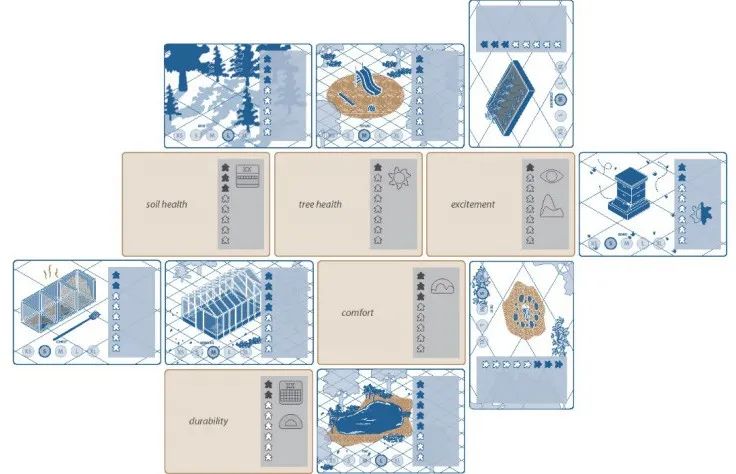
游戏结果示意
The game is meant to be printed and played at home. By providing a way for families to think about the design of their shared landscapes at their own convenience allows for more opportunities for people to initiate impactful conversations with landscape professionals and local community leaders. What remains is a specific platform for people to contact their local designers with the outcomes of their games, of which I can imagine ASLA chapters or city governments playing a part.
█ 与建筑相比,景观建筑是否是帮助改善和设计公共空间更有力的方式?
Do you consider landscape architecture as a more powerful tool than architecture to help change and design the public areas?
C:我在本科建筑学习结束之后工作了一年,回顾我的个人经历,我可能会说“是的”。景观建筑师因其对户外空间的关注从直觉上拥有改变和设计公共空间的能力。除了围绕系统思考和环境影响的探讨越来越多之外,这种特质还使景观设计师处于当前面临的设计挑战的关键位置。我选择在工作后去学习景观建筑的部分原因是,我发现了在公共项目中开展工作以及与更多人一起协作的潜力。
如果考虑专业的起源,比如在历史课的介绍中,景观建筑从最初便是一个公共课题。相关文献大量提及了该专业聚焦户外空间的体验以及人人都可以共享户外空间的特征。从我个人角度来看,在建筑领域会有更多的私人业务,比如为富裕的客户设计一些高端住宅等等。大多数时候,除非在公共机构工作,否则在建筑领域很难以公众为导向。这并不代表建筑公司就不从事公共工作或者不考虑公共空间,只是相比景观项目来说,公共性的体现并不是那么直观。
我的工作经历只是帮我迈出了思考公共工作的第一步,后来我申请了景观建筑的研究生项目更多地是出于自身兴趣。虽然我在纽约长大,目睹了各式各样的建筑,但我却痴迷于在山间远足。最近更是被城市农场和花园所吸引,这也是人们通常说到景观时脑海中会浮现的场景。同时,我也开始思考景观作为一种我们和彼此、和动植物以及土壤之间,超乎于个体与个体之间联系的媒介,这可能跟人们通常的认知不太一样。因此我认为就从事公共工作而言,每个人的选择是不同的。这取决于在景观建筑和建筑领域,你将什么人和哪些事物定义成“公众”和“公共的”,以及你对在这些实践和真实工作背后作为设计师的身份的定义。
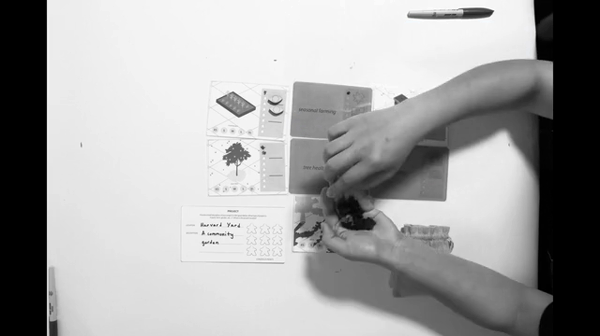
游戏过程
I worked one year in architecture after finishing architecture school. Looking back at my personal experience, I would probably say yes. Landscape architects intuitively have the power to change and design public spaces by virtue of its focus on outdoor spaces. This aspect, in addition to the increasing conversations around systems thinking and environmental impact, puts landscape architects at the nexus of current design challenges. Part of the reason why I went to study landscape architecture after working was that I started to see more potential for working on public projects and with more people in a collaborative process.
If you think about the origins of the profession, say in history class, landscape architecture started out as a public project. Related literature talks more about the experience of outdoor spaces, where everybody shares them. From my personal perspective, there will be more private commissions in architecture, like for wealthy clients for some high-end residential projects. Most of the time in the architecture field, it’s difficult to be publicly oriented unless you work for a public agency, but I don’t mean that architecture firms do not do public work or think about public spaces. It is just less intuitive compared to landscape projects.
I should say that my working experience was just one step towards helping me think about public work. It’s more of my own prior interests that led me to apply to a landscape architecture program afterward. Even though I was born and raised in New York City, which has lots of great (and not so great) architecture, I would feel driven to go hiking to be in the mountains and forests. More recently I’ve been drawn to urban farms and gardens. That’s what people usually think about when they think about landscape. However, I also started to think about landscape as an indicator of the relationships we have with one another, with plants and animals, and the soil—beyond a singular project—which may not be what people typically think about. So I think, in terms of pursuing public work, it’s a different choice for everyone. It depends on who or what you consider to be “the public” or “public” in landscape architecture and architecture, and where you see yourself as a designer in relation to these practices and the real work behind them.
█ 你如何看待景观游戏将作为一个有效途径让公众产生改善环境的个人责任感?景观游戏能够作为一种教育方式,让人们更有责任感?
How do you think landscape games will be an effective way for the public to feel responsible for changing our environment? Do you consider landscape games as an educational tool to make people feel more responsible?
C:景观游戏的目的不是转移职业责任,也不是说服不关心环境的人让他们突然产生责任感,即便这是有可能发生的。这个游戏意在成为一种工具,并通过适当的方式更好地帮助那些对关心环境的人们参与其中。
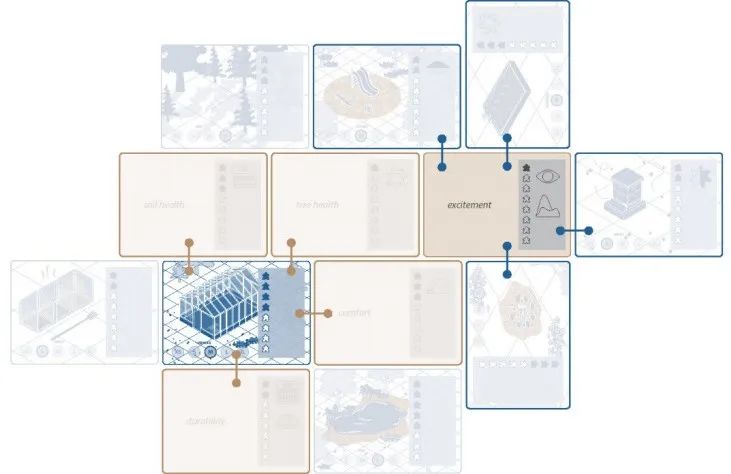
游戏结果分析
Landscape games are not meant to divert professional responsibility, nor to convince people who don’t care about their environment to suddenly feel responsible (although that may happen). They are meant as tools for people who do care, to better support them towards implementing changes in a sensitive way.
03 / 对景观学生的建议
Suggestions for Landscape Students
█ 对于ASLA学生奖,作品的图面表达是否很重要?
Do you think the graphics of the project also matters for the award?
C:是的。因为我的奖项类别略有不同,所以我有通过视频以及实体游戏成品来表述我的想法。我也知道一些朋友为参赛而重新绘图。说到平面表达,我认为涵盖不同类型的表达方式会对评奖有所帮助。这跟如何建立作品集的框架是一个道理,需要包括抽象图标,细节图纸以及实体模型的照片等。
Yes, I think so. My award category is a little bit different and I had videos or physical game pieces to communicate my ideas. But I do know some friends who redraw their work for the submission. Speaking of graphics, I think it’s helpful to have different types. It’s actually similar to how you would structure your portfolio, including abstract diagrams, very detailed drawings, and photos of physical prototypes.
█ 对有兴趣申请ASLA学生奖的同学,有什么建议吗?
For students who are interested in applying for the ASLA awards, do you have any suggestions or tips for them?
C:首先,参赛时选择适合的奖项类别。我提交的是交流沟通类而不是通用设计类,因为我的设计更多的是向外界传达什么是景观以及它可能是什么。虽说我觉得ASLA今年有增加更多的类别,但是首先,我认为你要找到自己有共鸣的主题或项目,兴趣会让你在这个项目上表现出色,同时你也要通过努力准备好所有材料。
提交参赛作品的当天,其实是我的毕业设计答辩,这有些令我感到压力很大。正如我之前所说,我已经在做整个毕业设计的过程中投入了所有的经历,我已经有了参赛需要的材料,需要做的只是提交。这真的是做喜欢并真正有价值的事。
另一个建议是,要在完成项目过程的中有计划的整理和完善零散的想法。在做一个好的项目的同时,清楚地表述想法也至关重要。参加该竞赛需要提交大量文字内容,我当时写了大约1500字来讲述设计。这既是对项目的阐述,又能帮助其他设计师理解你的设计作品,因此我会对写作十分重视。在哈佛大学设计学院GSD时,我曾做过学术写作助教并在图书馆工作,有机会写一些东西。
最后,善用提交补充材料的机会。组委会提供提交补充材料的选项,我寄出了我设计的游戏实物,同时也递交了所有相关视频的。多种媒介是、可以帮助别人看到作品不同角度。
One aspect that might be helpful in terms of the awards is selecting the right category. I submitted in the communication category instead of the design project because it was more about communicating what landscape is and what it could be. They are in fact adding more categories this year, I think. But first of all, it’s really important to find a particular topic or project that you really care about—your interest will drive you to do well on that project, and you will have all of the material (your hard work!) you need for your submission.
When I submitted for this award, it was actually the day of my thesis presentation, which was kind of stressful. The good thing was that I had already put all the investment into the project for my thesis. I had all the work done already. All I needed to do was submit it. It’s really just about working on something you enjoy and genuinely value.
A small tip that might be useful for submitting the work is actually putting together the writing part gradually over the course of your project. The award requires a good amount of text—I wrote about 1500 words—to explain the project. It’s a statement of your project and how you would like to communicate with other designers its importance. I would work on writing a lot, which has personally always been important to me. While at GSD, I was an academic writing tutor and worked in the library. I was surrounded by writing a lot and I feel like it’s always crucial to articulate your ideas besides doing a really good project.
Another helpful tip may be to submit supplements. They have an optional supplement choice, for which I sent a physical copy of the game I designed. I also submitted all the links to the videos that I produced. Using multi-media is a helpful way for people to see your project from different perspectives. So, if there’s the option for a supplement, definitely submit it!
█ 对跨专业话题感兴趣的同学,你有什么建议吗?
Do you have suggestions for people who're interested in cross-major topics?
C:我的建议是在设计开始之前,上一门相关的课程。如果是已经报满的课程,可以去询问教授要求旁听。我正是如此参加了一门对景观建筑学习很重要的课程。所以如果你真的想要学习一些东西,那就去上课吧,教授一定会同意的。
学习这些课程让我有机会接触到对不同话题感兴趣的人,也能够参与到学生组织举办的各种活动。学生们通常来自不同专业背景,这有助于我了解到不同的专业方向。同时也可以与教授进行交流,获取资源,比如课程大纲和阅读清单。
有三本书对我当时的跨界设计非常有帮助,作者是Austin Kleon,书名是《像艺术家一样剽窃》、《展示你的作品》以及《继续前进》。他们都是自我激励的图画书。我也会时常更新个人网站上的阅读清单(https://upinthenimbus.com/readinglist/),阅读大量书籍有助于我了解跨学科话题。
人们会在不同事物中寻找和发掘出与众不同的意义,就像我定义景观的方式或许就和其他人不同。而你需要做的是,找到对你来说重要的事情。有时只是需要一个契机,比如搬到另某个城市定居,当拥有足够的时间、舒适的空间及平和的心态时,在内心深处追问,你就会发现自己真正关心的是什么。通常情况下,这或许是一个包含许多主题的网络,上面所有的一切都与你自己息息相关。
If you are interested in doing something that is not or doesn't seem like it's specifically architecture. I would take a class, like in the MIT education department, for example, and I wouldn't wait until the thesis semester to do so. For some classes that were full, I simply just went and asked the professor if I could sit in the lecture. I was able to participate in one course that I felt was really important for my landscape architecture study by asking because I only had two years at GSD and not many electives. So if you genuinely want to learn something, just go and the professor will definitely say yes.
Taking those classes allowed me to be surrounded by people interested in different topics, and participate in a lot of events that were run by different student groups. People usually come from different backgrounds and have various concentrations, which helps me get to know the multiple aspects of various subjects. You can also talk to the professor who is teaching the class and ask for the syllabus and what the readings are. Getting resources is always helpful.
There are three books that I think are pretty helpful. Steal Like an Artist, Show Your Work and Keep Going by Austin Kleon. They are like self-motivation graphic books. I also have a reading list (https://upinthenimbus.com/readinglist/) on my personal website, which I try to keep updated. I think it’s pretty helpful to help understand cross-major topics.
People are going to find meanings in different things. Like the way I define landscape might be different from other people. You really want to find things that matter most to you. Sometimes it takes some time, like getting settled after moving to a different country or city. Deep down, when given the time and space—and peace of mind—you will find what you really care about, and it will likely be a web of many topics—all of which are connected to you.
访谈|马元鸣 Yuanming Ma, 栗茜 Sherry Li
文案/翻译|马元鸣 Yuanming Ma
校对|栗茜 Sherry Li,Yuxin Pan,鑫然 Sara Li
编辑|Winnie
审核编辑|Yibo
版权©建道筑格ArchiDogs,转载请联系media@archidogs.com
若有涉及任何版权问题,请联系media@archidogs.com,我们将尽快妥善处理。

